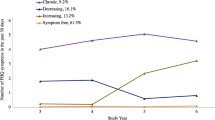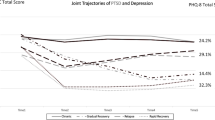Abstract
Purpose
The purpose of this study was to examine the prevalence, correlates, and symptom profiles of depressive disorders in men with a history of military service.
Methods
Data were obtained from the 2006 Behavioral Risk Factor Surveillance System survey. Multivariable logistic regressions were used to identify correlates of lifetime and current depression. Regularly occurring symptom profiles were identified via cluster analysis.
Results
Prevalence of lifetime and current depression was similar in men with and without a history of military service. Younger age was positively, and black minority status, being in a relationship and self-reported good health were negatively associated with a lifetime diagnosis of depression. Other minority status (non-Hispanic, non-black) was positively, and older age, some college, being in a relationship, and self-reported good health were negatively associated with current depression. A cluster of younger men who experience significant depressive symptoms but may not report depressed mood or anhedonia was identified.
Conclusions
Depression is as prevalent in men with a history of military service as it is in men without a history. Research should focus on subpopulations of men with a history of military service in which depression may be more prevalent or burdensome. Younger men with significant depressive symptoms may be missed by standard depression screens and still be at elevated risk for negative outcomes associated with depression.
Similar content being viewed by others
References
Lerner D, Adler DA, Chang H, Lapitsky L, Hood MY, Perissinotto C, Reed J, McLaughlin TJ, Berndt ER, Rogers WH (2004) Unemployment, job retention, and productivity loss among employees with depression. Psychiatr Serv 55(12):1371–1378
Harris EC, Barraclough B (1997) Suicide as an outcome for mental disorders: A meta-analysis. Br J Psychiatry 170(3):205–228
Wisqars Injury Mortality Reports 1999–2006 (2009) Available via internet. http://www.cdc.gov.ezpminer.urmc.rochester.edu/ncipc/wisqars/. Accessed 25 Sept 2009
Butler AC, Chapman JE, Forman EM, Beck AT (2006) The empirical status of cognitive-behavioral therapy: a review of meta-analyses. Clin Psychol Rev 26(1):17–31
de Maat SM, Dekker J, Schoevers RA, de Jonghe F (2007) Relative efficacy of psychotherapy and combined therapy in the treatment of depression: a meta-analysis. Eur Psychiatry 22(1):1–8
Frueh BC, Grubaugh AL, Acierno R, Elhai JD, Cain G, Magruder KM (2007) Age differences in posttraumatic stress disorder, psychiatric disorders, and healthcare service use among Veterans in Veterans Affairs primary care clinics. Am J Geriatr Psychiatry 15(8):660–672
Hankin CS, Spiro A 3rd, Miller DR, Kazis L (1999) Mental disorders and mental health treatment among U.S. Department of Veterans Affairs outpatients: the Veterans Health Study. Am J Psychiatry 156(12):1924–1930
Riddle JR, Smith TC, Smith B, Corbeil TE, Engel CC, Wells TS, Hoge CW, Adkins J, Zamorski M, Blazer D, for the Millennium Cohort Study, Team (2007) Millennium cohort: the 2001–2003 baseline prevalence of mental disorders in the U.S. Military. J Clin Epidemiol 60(2):192–201
Blazer DG, Kessler RC, McGonagle KA, Swartz MSv (1994) The prevalence and distribution of major depression in a national community sample: the National Comorbidity Survey. Am J Psychiatry 151(7):979–986
Kessler RC, Berglund P, Demler O, Jin R, Koretz D, Merikangas KR, Rush AJ, Walters EE, Wang PS, National Comorbidity Survey R (2003) The epidemiology of major depressive disorder: results from the National Comorbidity Survey Replication (NCS-R). JAMA 289(23):3095–3105
Department of Veterans Affairs (2001) 2001 National Survey of Veterans final report. Available via internet. http://www.va.gov/vetdata/SurveyResults/index.htm. Accessed 25 Sept 2009
Department of Veterans Affairs (2008) Health care eligibility and enrollment for Veterans. Available via internet. http://www4.va.gov/healtheligibility/eligibility/. Accessed 25 Sept 2009
Kroenke K, Spitzer RL, Williams JB (2001) The PHQ-9: validity of a brief depression severity measure. J Gen Intern Med 16(9):606–613
Kroenke K, Spitzer RL (2002) The PHQ-9: a new depression diagnostic and severity measure. Psychiatr Ann 32:1–7
Centers for Disease Control and Prevention (2009) BRFSS modules by category 2006. Available via internet. http://apps.nccd.cdc.gov.ezpminer.urmc.rochester.edu/BRFSSModules/ModByCat.asp?Yr=2006. Accessed 25 Sept 2009
Centers for Disease Control and Prevention (2007) Quality report handbook 2006. Available via internet. www.cdc.gov/brfss/technical_infodata/surveydata/2006/dqrhandbook_06.rtf. Accessed Mar 19 2009
Centers for Disease Control and Prevention (2007). BRFSS survey data 2006. Available via internet. http://www.cdc.gov/brfss/technical_infodata/surveydata/2006.htm. Accessed 25 Sept 2009
Kroenke K, Strine TW, Spitzer RL, Williams JB, Berry JT, Mokdad AH (2009) The PHQ-8 as a measure of current depression in the general population. J Affect Disord 114(1–3):163–173
Fan AZ, Strine TW, Jiles R, Mokdad AH (2008) Depression, anxiety associated with cardiovascular disease among persons aged 45 years, older in 38 states of the United States, 2006. Prev Med 46(5):445–450
Corson K, Gerrity MS, Dobscha SK (2004) Screening for depression and suicidality in a VA primary care setting: 2 items are better than 1 item. Am J Manag Care 10(11 Pt 2):839–845
Milliken CS, Auchterlonie JL, Hoge CW (2007) Longitudinal assessment of mental health problems among active and reserve component soldiers returning from the Iraq war. JAMA 298(18):2141–2148
Seal KH, Bertenthal D, Maguen S, Gima K, Chu A, Marmar CR (2008) Getting beyond “don’t ask; don’t tell”: An evaluation of US Veterans Administration postdeployment mental health screening of Veterans returning from Iraq and Afghanistan. Am J Public Health 98(4):714–720
STATA Statistical Software (2008) Version 10. STATA Corporation, College Station
Long JS, Freese J (2006) Regression models for categorical dependent variables using stata, 2nd edn. Stata Press, College Station
Rencher A (2002) Methods of multivariate analysis. Wiley, New York
Blashfield RK, Morey LC (1980) A comparison of four clustering methods using MMPI Monte Carlo data. Appl Psychol Meas 4(1):57–64
Calinski T, Harabasz J (1974) A dendrite method for cluster analysis. Commun Stat 3(1):1–27
Milligan GW, Cooper MC (1987) Methodology review: clustering methods. Appl Psychol Meas 11(4):329–354
Kowalski J, Tu XM (2007) Modern applied U-statistics. Wiley, New York
Statistical Analysis Software (SAS) (2008). Version 9.2. SAS Inc., Cary
Fiedler N, Ozakinci G, Hallman W, Wartenberg D, Brewer NT, Barrett DH, Kipen HM (2006) Military deployment to the Gulf war as a risk factor for psychiatric illness among US troops. Br J Psychiatry 188:453–459
Hoge CW, Castro CA, Messer SC, McGurk D, Cotting DI, Koffman RL (2004) Combat duty in Iraq and Afghanistan, mental health problems, and barriers to care. N Engl J Med 351(1):13–22
Hoge CW, Auchterlonie JL, Milliken CS (2006) Mental health problems, use of mental health services, and attrition from military service after returning from deployment to Iraq or Afghanistan. JAMA 295(9):1023–1032
Shalev AY, Freedman S, Peri T, Brandes D, Sahar T, Orr SP, Pitman RK (1998) Prospective study of posttraumatic stress disorder and depression following trauma. Am J Psychiatry 155(5):630–637
Kinder LS, Bradley KA, Katon WJ, Ludman E, McDonell MB, Bryson CL (2008) Depression, posttraumatic stress disorder, and mortality. Psychosom Med 70(1):20–26
Lenze EJ, Rogers JC, Martire LM, Mulsant BH, Rollman BL, Dew MA, Schulz R, Reynolds CF 3rd (2001) The association of late-life depression and anxiety with physical disability: a review of the literature and prospectus for future research. Am J Geriatr Psychiatry 9(2):113–135
Dotson VM, Resnick SM, Zonderman AB (2008) Differential association of concurrent, baseline, and average depressive symptoms with cognitive decline in older adults. Am J Geriatr Psychiatry 16(4):318–330
Buckner JD, Joiner TE Jr, Pettit JW, Lewinsohn PM, Schmidt NB (2008) Implications of the DSM’s emphasis on sadness and anhedonia in major depressive disorder. Psychiatry Res 159(1–2):25–30
Cuijpers P, Smit F (2002) Excess mortality in depression: a meta-analysis of community studies. J Affect Disord 72(3):227–236
Cavanagh JTO, Carson AJ, Sharpe M, Lawrie SM (2003) Psychological autopsy studies of suicide: a systematic review. Psychol Med 33(3):395–405
James A, Lai FH, Dahl C (2004) Attention deficit hyperactivity disorder and suicide: a review of possible associations. Acta Psychiatr Scand 110(6):408–415
Zivin K, Kim HM, McCarthy JF, Austin KL, Hoggatt KJ, Walters H, Valenstein M (2007) Suicide mortality among individuals receiving treatment for depression in the Veterans Affairs health system: associations with patient and treatment setting characteristics. Am J Public Health 97(12):2193–2198
Gallo JJ, Bogner HR, Morales KH, Post EP, Ten Have T, Bruce ML (2005) Depression, cardiovascular disease, diabetes, and two-year mortality among older, primary-care patients. Am J Geriatr Psychiatry 13(9):748–755
Simpson G, Tate R (2007) Suicidality in people surviving a traumatic brain injury: Prevalence, risk factors and implications for clinical management. Brain Inj 21(13–14):1335–1351
Cully JA, Zimmer M, Khan MM, Petersen LA (2008) Quality of depression care and its impact on health service use and mortality among Veterans. Psychiatr Serv 59(12):1399–1405
Kuehn BM (2009) Soldier suicide rates continue to rise: Military, scientists work to stem the tide. JAMA 301(11):1111
Galea S, Tracy M (2007) Participation rates in epidemiologic studies. Ann Epidemiol 17(9):643–653
Author information
Authors and Affiliations
Corresponding author
Rights and permissions
About this article
Cite this article
Britton, P.C., Bossarte, R.M., Lu, N. et al. Prevalence, correlates, and symptom profiles of depression among men with a history of military service. Soc Psychiatry Psychiatr Epidemiol 46, 607–614 (2011). https://doi.org/10.1007/s00127-010-0226-y
Received:
Accepted:
Published:
Issue Date:
DOI: https://doi.org/10.1007/s00127-010-0226-y




